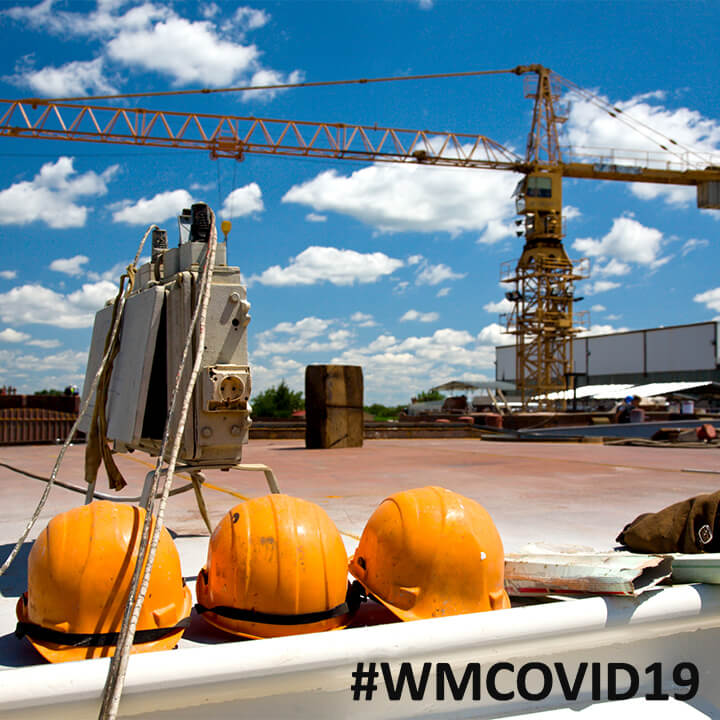Environmental risks with closed construction sites
21st April 2020
Introduction
Coronavirus (COVID-19) continues to have a dramatic and unavoidable impact across the construction industry. This note considers some of the key environmental issues to be aware of where a site has been or will be temporarily closed due to the COVID-19 outbreak.
Whilst the UK government does not currently require all construction sites to close, many sites have already closed or will close temporarily. Over the last few weeks, much guidance has been issued regarding the effects of such closures on project completion dates, costs overruns and the parties’ respective rights under typical forms of construction contracts in respect of the same.
Whilst these issues are clearly of paramount importance to those involved with any construction project, the parties should also be mindful of the steps which need to be taken in order to ensure that any closures can be achieved as safely as possible and avoid potential issues while the site is not active. For example, what would happen in the event that there is a significant pollution or contamination incident involving a construction site whilst works are suspended/there is a much reduced physical presence on site?
Who takes the blame if there is a pollution or contamination incident?
Contamination from historic uses or pollution spills can migrate off-site or on-site for various reasons including:
- Many types of contaminants are mobile and can migrate significant distances in groundwater and surface water.
- New contamination can interact with existing contamination and result in chemical or biological changes.
- Construction work, remediation, intrusive investigations, mining or other disturbance of the ground can mobilise existing contamination or create pathways for the pollution to escape.
- Flooding can mobilise residual contamination.
Where proper containment measures are not put in place, there is clearly an increased risk of contamination occurring where a construction site has been temporarily closed. Similarly, the absence of a physical presence on site increases the risk of relatively minor pollution incidents going unnoticed and developing into a much greater problem. Who bears responsibility for such contamination or pollution will to some extent depend on what your contract says. However, there are some general rules of application as set out in brief below.
Contaminated Land Regime
The contaminated land regime set out in Part 2A of the Environmental Protection Act 1990 (EPA 1990) is the statutory regime for identifying contaminated land and allocating responsibility for remediation. This regime is one of several ways in which contaminated land can be addressed (e.g. the planning system, environmental permitting etc.).
“Contaminated land” is defined in Part 2A of the EPA 1990 as any land which, by reason of substances in, on or under the land, appears to be in such a condition that either of the following apply:
- significant harm to the environment or human health is being caused, or there is a significant possibility of such harm being caused; or
- significant pollution of controlled waters is being caused, or there is a significant possibility of such harm being caused.
The EPA 1990 identifies who may be an “appropriate person” (i.e. who is liable) to remediate the contaminated land. In this regard, a person is liable if they “caused or knowingly permitted” the contaminating substance “to be in, on or under” the land in question. If no such person, “after reasonable inquiry”, can be found, the responsibility for remediation falls to the owner or occupier of the land (save for incidents that relate solely to the pollution of controlled waters).
Once contamination has been identified and responsibility allocated, the relevant enforcing authority (the local authority, the Environment Agency (EA) or Natural Resources Wales (NRW)) will then need to determine how it should be remediated. The overarching objectives, in taking such action, are to: (i) ensure the contaminated land is made suitable for its current use; and (ii) remove unacceptable risks to human health and the environment.
As above, liability extends not only to an original causer of the pollution, but also to someone who “knowingly permitted” the risk of harm through contamination. In the context of a closed construction site, liability would most likely sit with either the:
- Developer: The developer usually takes 100% responsibility for the costs of remediation action (investigations, clean up and post-remediation monitoring) under planning conditions. It is worth noting that developers often seek to pass this liability down to contractors by including specific provisions to this effect in construction contracts.
- Contractor: For example, by causing pollution or migration by disturbing the ground and mobilising contaminants, creating pathways, or removing protective hardstanding. The Contractor may also have accepted liability, for any enforcement action under the contaminated land regime, in the construction contact.
A buyer/subsequent owner could (through no fault of their own), be liable for remediation of contaminated land where it is not possible to identify the original causer of the pollution (albeit that this scenario is more likely to arise where construction has completed and the original developer has disposed of its interest in the site and is no longer around to carry out the necessary remediation).
Environmental Permitting Regime
Special regard will need to be paid to sites regulated by an environmental permit. Care will also be required on sites which do not already have a permit, but which could be at risk of a breach of the permitting regulations in the event of a pollution incident, such as polluting substances from a site entering a water course.
The Environmental Permitting (England and Wales) Regulations 2016 provides that it is an offence to operate a regulated facility or undertake specific activities (e.g. water discharges) unless an environmental permit is in place. Perhaps more relevant at the present time, an offence is also committed if the permit-holder fails to comply with an environmental permit condition. These are strict liability offences and therefore the enforcing authority is not required to prove intent.
The fines that can be imposed by the Courts are unlimited and therefore the consequences of committing an offence can be severe.
It is therefore important that if any issues have arisen during the closure of a site that they are investigated promptly. It will also be prudent to liaise closely with the Environment Agency as soon as possible. For example, if there has been an unavoidable breach of a permit condition due to COVID-19 then early communication with the Environment Agency, alongside independent expert advice, will usually be beneficial.
Management of Waste
The proper handling of waste may also be an issue when sites have been, or are being, urgently closed.
An offence is committed under the Environmental Protection Act 1990 if waste is deposited on land without an environmental permit (or if a party knowingly causes or knowingly permits the deposit) or if waste is not managed properly on site. An offence can lead to an unlimited fine being imposed, so again the consequences can be very significant.
We would recommend paying particular attention to the following points:
- Where possible, ensure all skips and bins (particularly if containing biodegradable waste) are collected and emptied in advance of the site closing by a properly licensed collector.
- If this is not possible, ensure all waste containers are covered and secured.
- Ensure any hazardous wastes (e.g. soils containing asbestos, COSHH wastes) are separated and stored safely, with signage erected that highlights their harmful nature. Arrange for the hazardous waste to be removed by an authorised collector.
- Continue to maintain a proper inventory of transfer notes and consignment notes.
- Take all reasonable steps to maintain site security and fire safety precautions so as to reduce the risk of trespass or arson leading to an escape of waste or pollution incident.
Practical/special consideration for environmental issues
As the old saying goes, prevention is better than cure. To this end, on 30 March 2020, the Construction Leadership Council (CLC) published its Advice on temporary suspension of sites (Advice), which provides both construction companies and clients guidance on closing a construction site in light of the COVID-19 pandemic.
As well providing useful guidance in relation to (amongst other things) site safety, site security and insurance issues, the Advice includes a helpful checklist of matters for the parties to consider in the context of environmental issues on closed construction sites as follows:
River, coast and reservoir issues
Where the site is near a river, estuary or the coast, where there is a risk of flooding or coastal erosion:
- the parties must determine and provide temporary arrangements including monitoring arrangements to avoid increased risks of flooding or coastal erosion with consequent risk to life and property; and
- river or coastal defences must not be left in a compromised, lowered, weakened, or unstable condition. Works must not be left impeding a river channel unless agreed with the risk management authority.
Where a site impacts a reservoir covered by the Reservoirs Act, temporary arrangements must be agreed with the reservoir panel engineer.
Where a site poses a risk of pollution, you should ensure this risk is removed or minimised prior to the shutdown and that monitoring arrangements are put in place if necessary to ensure that any new risks arising are promptly dealt with.
If the activity requires a permit you should ensure you notify the regulator of the shutdown and how you intend to comply with any relevant conditions to prevent pollution occurring.
Water related risks (including over-pumping and dewatering activities)
Assess the risk of all activities that may directly impact water quality and plan for worst case scenario (i.e. the weather is currently dry and warm, but could change significantly over coming weeks).
Where possible and safe to do so, any activities that could impact on the water environment that can be halted should be done so to minimise risk of uncontrolled future failure.
If working within a flood plain, move all plant and equipment to higher ground in case water levels rise while the site activities are suspended.
For water management processes that need to remain in place, ensure operational control is maintained (many of these systems can be used remotely for relatively long periods of time). The maintenance regime (including refuelling of pumps) will need to be considered.
Make plans to monitor the site either remotely where possible (i.e. CCTV) or ensure regular checks are carried out during the period the site activities are suspended.
Ensure drains are protected from uncontrolled run off that may contain pollutants.
Ecology related risks
The majority of ecological species are unlikely to present an environmental risk while activities are suspended; but consider risk of vermin if bins are not able to be emptied.
Where possible, ensure that any critical elements that will require immediate utilisation once works resume are protected from nesting birds that could use the quiet period of reduced activity to nest on works equipment, plant or work faces.
Due to the timing (spring season) when work does resume consideration should be given to the risk of other protected species establishing habitat in or around construction sites. A thorough check should be made of all work areas prior to recommencing activities. To mitigate this risk, it would be prudent to take steps now to prevent protected species accessing the site. If they are able to access the site, then this could create a scenario whereby works cannot recommence until a protected species licence has been obtained.
Any ecology work that has previously been undertaken in relation to the site should be reviewed. If this work indicated there are protected species in the vicinity of the site then preventative measures should be taken. If no ecology work is available, then it would be prudent to take advice from an ecologist (particularly if the site is to be closed for an extended period).
Insurance
The CLC also advises parties involved in a construction project to revisit their insurance policies relating to the site and to make sure that they remain appropriate for the temporary closure. Where required, the parties should also inform the insurer of the shutdown.
Whilst not specifically mentioned in the Advice (and appropriate insurance advice should always be taken), in the context of environmental issues, it would be prudent for the parties to:
- check that environmental consultants and contractors have sufficient cover under their professional indemnity (PI) and public liability insurance policies; and
- review any specific environmental insurance products which apply to the project (e.g. Contractors Pollution Liability policies and Pollution Legal Liability policies).
If you would like to discuss this note further please contact Alison Ogley, Alastair Robertson or Josh Kitson.





